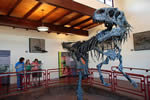 Cleveland-Lloyd Dinosaur Quarry, located in the San Rafael Swell, near Cleveland, Utah, contains the densest concentration of Jurassic-aged dinosaur bones ever found. More than12,000 bones (belonging to at least 74 individual dinosaurs) have been excavated at the quarry.
Cleveland-Lloyd Dinosaur Quarry, located in the San Rafael Swell, near Cleveland, Utah, contains the densest concentration of Jurassic-aged dinosaur bones ever found. More than12,000 bones (belonging to at least 74 individual dinosaurs) have been excavated at the quarry.
Cleveland-Lloyd Dinosaur Quarry has helped paleontologists learn a great deal about the Jurassic period, yet the site presents at least as many mysteries as it helps to solve. Curiously, more than 75 percent of the bones come from carnivores, primarily Allosaurus fragilis. With more than 46 individual specimens of Allosaurus, scientists have been able to deduce much about how the Allosaurus aged and compare individuals to better understand intraspecies diversity.
Yet the sheer density of bones proposes many questions. How did the carcasses of so many animals end up in one place, and why are most of them meat-eaters? While many good hypotheses have been presented they all still have major flaws, so the mystery continues to be unsolved.
The quarry was found by sheepmen and cowmen as they drove their animals through the area during the late 19th century. In 1927, the Department of Geology at the University of Utah, under the direction of Chairman F.F. Hintze, visited the area and collected 800 bones. In 1939, a field party from Princeton University led by William Lee Stokes began work. In three summers, they collected 1,200 bones.
The quarry was not worked again until 1960. In 1974, a new dinosaur was described by James H. Madsen, Jr., assistant research professor of geology and geophysics, University of Utah. He named it Stokesosaurus clevelandi. In 1976, another new dinosaur was described from fossils found in the quarry by Madsen. He named it Marshosaurus bicentesimus. In 1987, Brigham Young University paleontologists excavated a fossil dinosaur egg, at the time the oldest such egg ever found.
 Over the years, excavations led by the University of Utah and the Utah Museum of Natural History have resulted in the collection of more than 12,000 fossil bones from the quarry. While most of the original fossils are currently housed at the Utah Museum of Natural History, many skeletons reproduced from Cleveland-Lloyd dinosaur remains are now on exhibit in more than 65 museums worldwide.
Over the years, excavations led by the University of Utah and the Utah Museum of Natural History have resulted in the collection of more than 12,000 fossil bones from the quarry. While most of the original fossils are currently housed at the Utah Museum of Natural History, many skeletons reproduced from Cleveland-Lloyd dinosaur remains are now on exhibit in more than 65 museums worldwide.
Original specimens from the quarry remain on public exhibit in Utah at the Utah Museum of Natural History in Salt Lake City, the College of Eastern Utah Prehistoric Museum in Price and the Earth Science Museum at Brigham Young University in Provo.
The U.S. Department of the Interior, Bureau of Land Management (BLM) opened a visitor center at the Cleveland-Lloyd Dinosaur Quarry in 1968. This was the first-ever BLM visitor center. On April 28, 2007, a new, larger facility was dedicated that has updated exhibits. The new visitor center generates its own electricity from rooftop solar panels.
Today, at the Visitor Center you can see a complete Allosaur skeletal reconstruction and a Stegosaur wall mount. At the quarry you can view the work in progress in a covered building, where you can see actual bones in place. Recognized worldwide as the primary source of fossilized bones from the flesh-eating Allosaur, the quarry was designated a National Natural Landmark in 1966.

